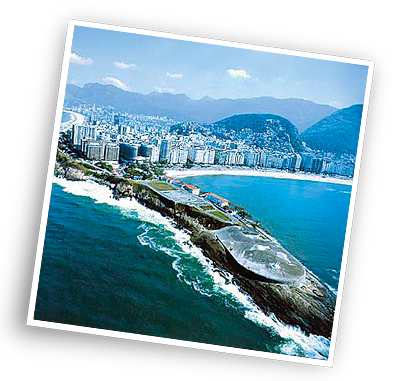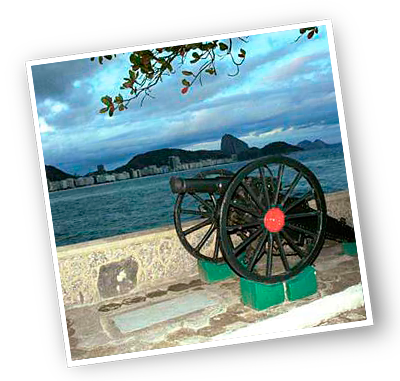A Stunning Landscape
The historic Fort Copacabana is open to visitors!
Sources: http://www.marcillio.com/rio/encopaca.html#his e Wikipédia
In 1770, coming back from Africa, Friar Antonio do Desterro almost died in a shipwreck, near where there was a chapel with images of Our Lady of Copacabana. In the midst of his misery, he promised that, if he survived, he would erect a shrine to the Saint in that place - and so he did, bringing to the building a replica of the image of the saint from the Viceroyalty of Peru, close to Lake Titicaca, in a region which now belongs to Bolivia, where the Spanish erected a chapel to Our Lady of Candelaria, later known as Our Lady of Copacabana.
Thus the name of the neighborhood was born...
Copacabana Beach has always been important under a strategic point of view for protection of Guanabara Bay. Leme Fort exists since the 18th century, to protect the entrance of Guanabara Bay, opposite to the Fortress of Santa Cruz da Barra in Niterói, which dates back to the 17th century.
The Fortress at Ponta da Igrejinha (“Little Church Peninsula“) in Copacabana started to be idealized in 1893 by Engineer Major Augusto Tasso Fragoso, who drafted a modern fortification, equipped with six long-range cannons, but the project of the new fortification was shelved. And so it remained until Marshal Hermes da Fonseca, in the post of Minister of War during the Afonso Pena office, was authorized to carry out the works.
Works in the Fortress began on January 6, 1908, under the guidance of military engineer Major Luís Eugênio Franco Filho and coordinated by Major Arnaldo Pais de Andrade. The pieces came disassembled from Germany, in five thousand crates, shipped and disembarked on a dock specially built for that purpose at the site, whose remains can be seen to this day.
The work would only be inaugurated as Fort Copacabana on September 28, 1914, classified as 1st Class and considered at the time the most modern fortress in South America and a milestone for the military engineering of its time.
Five years after the inauguration of the fort, in 1919, the adjacent land was purchased from the Diocese, and the little church built by Friar Antônio was demolished to make way for the Peace Barracks, concluded on October 1920.
Therefore, the area around the Fortress at Ponta da Igrejinha in Copacabana, which for a long time remained a Fishing Community, far from the city center, now houses Fort Copacabana, which recently had part of its facilities turned into a cultural center and is open to visitors, offering the contemplation of a piece of Rio de Janeiro’s history and an incomparably beautiful landscape.
Vitacura is also a part of this progress story, since 2006 having a Shop within the Fort facilities in Copacabana. There the tourist can purchase miniature soldiers, beautiful photographs of Copacabana Beach, in addition to T-shirts, bags, flip-flops and various gifts with the Copacabana Promenade pattern.
Come visit the monument and get to know the
Vitacura Shop at Fort Copacabana!Back to home page


